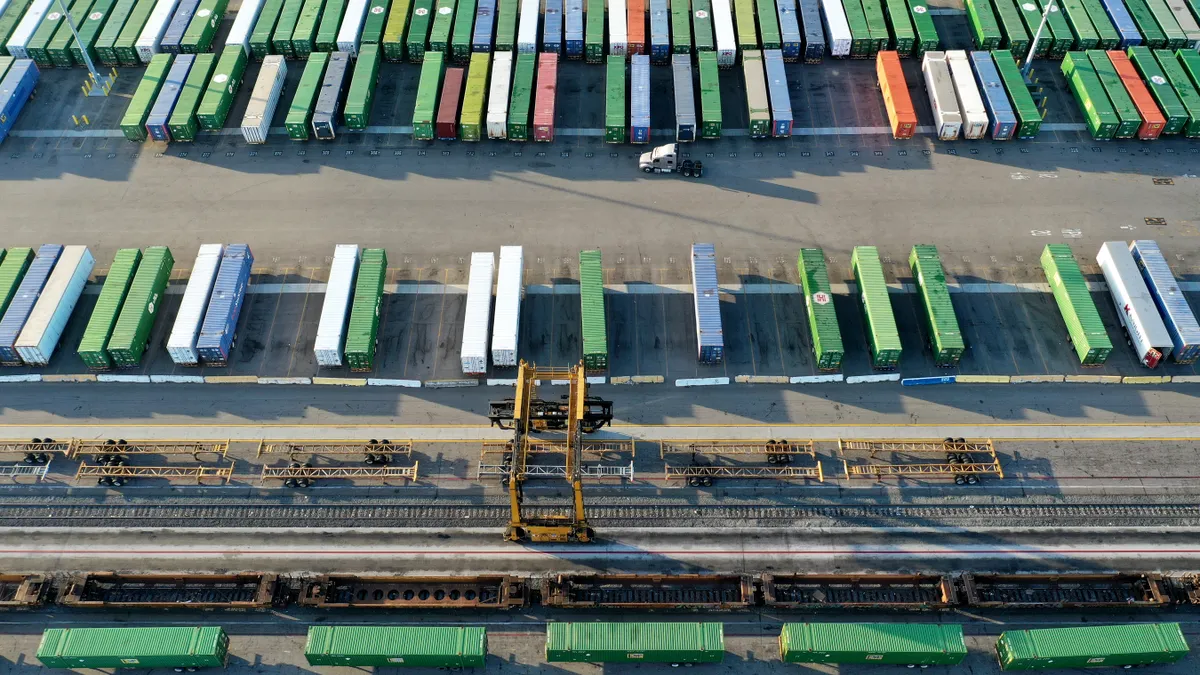Dive Brief:
- The Surface Transportation Board issued a new reciprocal switching rule on Thursday that would entitle shippers to request relief from a nearby railroad if their existing carrier is not meeting minimum service standards.
- Under the notice of proposed rulemaking, the railroad regulator would use three metrics to prescribe reciprocal switching agreements between Class I railroads: service reliability, service consistency and whether there is inadequate local service.
- Shippers’ reciprocal switching requests will be denied if their traffic has increased at least 20% over a 12-week period. For seasonal industries like agriculture, shippers will have to provide railroads with written notice 12 weeks in advance before an expected traffic surge occurs.
Dive Insight:
Shippers have been pushing for a reciprocal switching rule for years, arguing such a rule could offer shippers relief when service levels deteriorate on any railroad and incentivize carriers to improve service.
A reciprocal switching agreement would allow parties to transfer a rail shipment from one Class I carrier to another. While shippers have had the ability to request a reciprocal switching order for decades, no rail customer has requested one since before 1990 due to regulatory hurdles, STB Chairman Martin Oberman said in a statement.
The new proposed rule clarifies the process by which a shipper can request a reciprocal switching agreement by providing a more granular approach. The STB, for example, seeks to clearly define where a reciprocal switch can take place — in a terminal area, defined as a facility where two or more rail carriers collect, classify, and distribute shipments for line-haul service — and proposes data benchmarks to define when railroad service levels could be deemed insufficient.
“This rule will bring predictability to shippers and will provide Class I carriers with notice of what is expected of them if they want to hold on to their customers who might otherwise be eligible to obtain a switching order,” Oberman said. “As a result, litigation costs to obtain a switch should be greatly reduced and petitions to obtain a switching order should be able to be litigated much more swiftly.”
Regulators propose 3 service metrics to assess need for reciprocal switching
| Metric | Regulatory definition | Proposed benchmark |
| Service reliability | The measure of a Class I rail carrier’s success in delivering a shipment by the original estimated time of arrival that the rail carrier provided to the shipper. | Success in service reliability means 60% of shipments should arrive within 24 hours of the original estimated time of arrival. The STB is also considering whether 60% should be the permanent service requirement, or if it should raise it to higher than 70% after the second year. |
| Service consistency | The measure of a rail carrier’s success in maintaining, over time, the carrier’s efficiency in moving a shipment through the rail system. | A petitioner would be eligible for relief if the average transit time for shipment of a loaded car, unit train or empties increased by 20% or 25%, as compared to the average transit time for the same twelve week period the previous year. |
| Inadequate local service | The measure of a rail carrier’s success in performing local deliveries (“spots”) and pick-ups (“pulls”) of loaded railcars and unloaded private or shipper-leased railcars within the applicable service window, often referred to as “industry spot and pull” or ISP. | A rail carrier would fail the standard if the carrier had an ISP success rate of less than 80% over a period of 12 consecutive weeks, in performing local deliveries and pick-ups within the applicable service window. |
SOURCE: Surface Transportation Board
Railroads have been under fire from the STB over their service levels for more than a half a decade.
Since 2016, shippers have complained to the oversight board of deteriorating performance as railroads adopted an operating model known as precision scheduled railroading. They’ve also faced delays or congestion over the years. And while many can switch their loads to trucks, others — often in the agriculture industry — rely entirely on rail service to move their goods due to logistical constraints.
Shippers have argued that reciprocal switching would create more competition in a consolidated rail industry, and in turn pressure carriers to offer lower rates and better service. Railroads have said the opposite, contending it could exacerbate delays by forcing additional complexity into their operations.
Dan Elliott, a former STB chairman who now represents the Private Railcar Food and Beverage Association, explained in a hearing last year how reciprocal switching could help captive shippers who rely on rail to keep operations going. Service problems by a Class I carrier closed a Kraft Heinz facility in North Florida for an entire week at one point, as the shipper was unable to find alternate transportation.
“Despite numerous pleas to the railroad, nothing was done to remedy the situation despite these dire consequences,” Elliott said. “If reciprocal switching had been a possibility, it likely would have been able to prevent the Kraft Heinz plant from being shut down by using another nearby Class I railroad.”
Ongoing service issues since 2016 prompted the STB to increase oversight of Class I railroads’ operations. Oberman said that the proposed reciprocal switching rule will incentivize carriers to maintain sufficient resources and service levels.
“One hope is that the proposed rule will have the desired effect and that shippers currently receiving poor service will see service improve to the point that litigation before the Board will not be necessary,” the chairman said in a statement.
In addition to enabling reciprocal switching, the rule would make some data reporting requirements permanent, would force all Class I carriers to standardize their service metrics, and would require railroads to share relevant historical data with customers upon request.
The proposed rule replaces a previous proposal issued in 2016, which generated significant support from shippers and opposition from rail carriers in public comments, according to the STB. Comments on the latest rule are due by Oct. 23, and replies must be submitted by Nov. 21.
Oberman added the STB expects to act “expeditiously” on finalizing the standards on the proposal once comments are submitted, given its expected impact on rail service levels.













